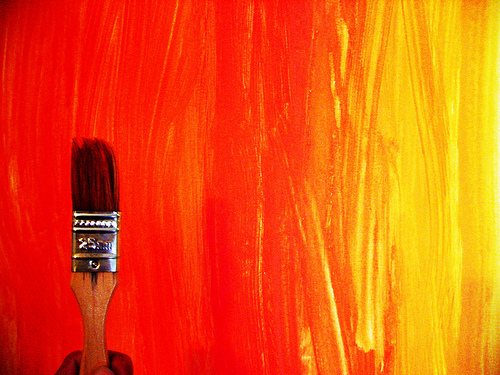
Red reduces analytical thinking

There’s a reason why red cars in most Western countries cost more to insure. When humans see the colour red, their reactions become more forceful, leading to more accidents. However, that boost of energy is likely to be transitory and ultimately, red reduces analytical thinking. Research conducted by Andrew Elliot, professor of psychology at the University of Rochester, shows that athletes are more likely to lose when they compete against an opponent wearing red and students exposed to red before a test are likely to perform worse. Although research indicates that red can be helpful if you’re trying to appear more attractive and elegant to friends or colleagues, it isn’t helpful if you need to stay on task. “One reason why red makes it hard to concentrate is tied to a cultural-specific issue,” says environmental psychologist Sally Augustin. “Those of us who got a lot of answers wrong as children, may associate the color red with the red ink our teachers used to mark our papers.”
Blue is most accepted

Blue is the colour of the psyche and is essentially soothing; it affects humans mentally, rather than the physical reaction we have to red hues. Strong blues like navy and teal-blue will stimulate clear thought and lighter, soft blues like sky tones will calm the mind and aid concentration. Consequently, it is serene and spiritually calming, evoking a positive focus. It is the colour of comprehensible communication. Blue objects do not appear to be as close to us as red ones. Time and again in research, blue is the world’s favourite colour. However, it can be perceived as cold, unemotional and unfriendly. Hospitals very frequently stick to a blue colour scheme. However, painting a common area of an office building blue is likely to satisfy the majority of people.
Yellow isn’t usually a hit

The yellow wavelength is comparatively long and essentially stimulating. It projects an emotional stimulus, therefore, yellow is the strongest tint, psychologically. The right shade of yellow will lift your spirits and self-esteem; it is the colour of confidence and optimism. Too bright or too dim yellow tones in relation to the other tones, can cause self-esteem to plummet, giving rise to fear and anxiety. Avoid painting public spaces yellow because most people aren’t fans of the hue. Shades of yellow remain the least likely favourite for most people, so pick a different colour if you want to appeal to the masses. Bright yellow though can grab customers’ attention, stopping them on their way before they walk by a product display. That’s because yellow is the colour first perceived by the retina, according to retail design consultant Linda Cahan.
Orange is associated with good value

Orange tones help customers view associated products as a low cost source of valuable goods. High-end retailers have been able to overcome this association with the colour and have successfully incorporated orange into their brand. Warm colours like oranges and browns are inviting and reassuring to consumers, while cooling colours like green and blue can have a comforting effect, says retail consultant Georganne Bender. “Orange makes you happy,” she says. And happy customers are more likely to linger longer in your store. When Carol Winston moved women’s shop Accessories From The Heart to a new location, she decided to change the white walls to burnt orange. At night, under the store’s halogen lighting, the interior gives off a warm restful glow. “When it gets dark, the store looks like a jewellery box,” Winston says. “It’s really inviting.”
Pink calms people down

Being a tint of red, pink also affects us physically, but it soothes, rather than stimulates. Pink is a powerful colour, psychologically. It represents the feminine principle, and survival of the species; it is nurturing and physically soothing. Too much pink is physically draining and can be somewhat emasculating. There’s a reason some sports teams paint the opposing team’s locker room pink – it’s known for draining people of their energy. Baker-Miller-pink (medium pink) calms people down for about half an hour, according to environmental psychologist Augustin. Once people have remained peaceful for that time frame, they’re often able to remain in a composed state. This could be a great colour for lawyers who are conducting mediation or a board room where conversations may get heated.
White may lead to boredom

The white hue denotes total reflection. In effect, it reflects the full strength of the spectrum into our eyes. Thus creating barriers, but differently from black, and it is often a strain to look at. It communicates a “Touch me not” kind of air. White is purity and, like black, uncompromising; it is clear, hygienic, and sterile. The concept of sterility can also be negative though. Visually, white gives a sharp perception of space. The negative effect of white on warm colours is to make them look and feel brash. White has a modern appeal. Apple, for example, has used white to brand their clean, smooth look. However, too much of a monochromatic look can cause people to reflect on their own thoughts, warns Augustin. A person shopping in a monochromatic store may become distracted from the task at-hand when their mind begins to wander due to the lack of stimulation.
Published in The Express Tribune, December 8th, 2014.
Like Life & Style on Facebook, follow @ETLifeandStyle on Twitter for the latest in fashion, gossip and entertainment.






1732361617-0/Untitled-design-(4)1732361617-0-270x192.webp)

1732308855-0/17-Lede-(Image)1732308855-0-270x192.webp)








COMMENTS
Comments are moderated and generally will be posted if they are on-topic and not abusive.
For more information, please see our Comments FAQ